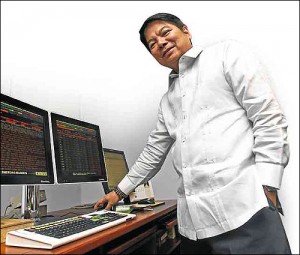Despite local interest rates now at historic lows, the head of the Bangko Sentral ng Pilipinas has indicated that further cuts could come to head off the destabilizing effects of an overly strong peso.
Speaking to Bloomberg TV on Saturday, BSP Governor Amando M. Tetangco Jr. also said that monetary authorities might have to be more creative in order to insulate the local economy from the negative effects that massive dollar inflows could bring, especially as the Christmas remittance season approaches.
“Growth prospects would be deemed as principal driver of capital flows but interest rate differentials also play a role,” Tetangco said. “So I think there’s scope for trying to influence capital flows by interest rate adjustment.”
His comments on the possibility of another round of monetary policy easing comes on the heels of the BSP’s decision to reduce its key overnight rates by 25 basis points just last Thursday.
The central bank’s overnight borrowing rate stands at a historic low of 3.5 percent after last week’s adjustment, which officials said was due to the benign inflation environment, but was widely understood as a move to help curb the peso’s rise.
The upward pressure on the local currency may become more pronounced with the approach of the holiday season when most expatriate Filipino workers send dollars home to their relatives.
“We need to consider responses other than adjustments in policy rates to deal with inflows,” Tetangco said. “For example, we can allow some currency appreciation for structural flows. And we can use macroprudential tools to dampen any upward asset price pressures.”
Taking his cue from the US Federal Reserve’s signal that global interest rates were set to remain low over the medium term, the central bank chief said that “emerging market economies like the Philippines will have to remain creative in terms of their policy tool kits to address inflows and their effects.”
The peso has so far appreciated by 6 percent this year against the dollar, prompting exporters to complain that the strong currency was making Philippine products more expensive in foreign markets.
Amid calls for the government to intervene to cap the peso’s rise, the BSP has maintained that the foreign exchange rate would remain market-determined, with occasional interventions being limited to smoothening out extreme volatility.
In addition to the ill-effects of a strong peso on exporters, the central bank also has to deal with the massive cost to the regulator’s balance sheet of neutralizing the excess liquidity in the financial system caused by foreign inflows.
“Contrary to the perception of some policy makers, there’s a real cost to the economy from capital surges in terms of stabilization, for instance, when markets overshoot,” he cautioned. “So we need to be watchful of this as well.”
Tetangco boosted the prospects of another rate reduction, explaining that while interest rate differentials between the Philippines and advanced economies were not the main driver of capital flows, “they continue to be a significant factor.”
